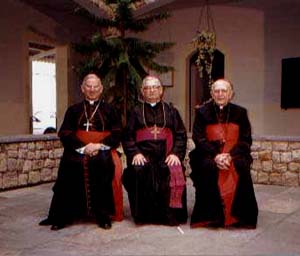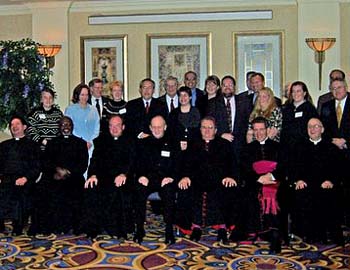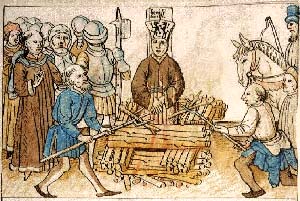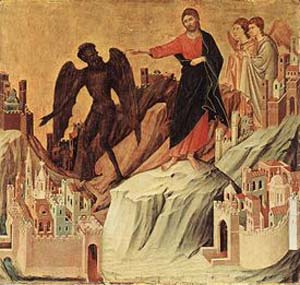 |
Traditionalist Issues
A Lesson Not To Be Forgotten
Bishop Rifan’s Betrayal
Atila Sinke Guimarães
As a priest Fernando Rifan was a very influential leader, one of the six top men with the power of decision in the Society of St. Pius X, according to a very high and credible insider of the SSPX who, some months before Rifan’s defection, spontaneously assured me.

2002, in Brazil, left to right, Cardinal Royos, Bishop Licinio Rangel, Cardinal Eugenio Sales. Rangel was made a Bishop in reward for his signature |
Then, a new opportunity to climb the career ladder appeared. Faced with terminal cancer, Msgr. Licinio Rangel, the successor of Bishop Castro Mayer at the head of the Fraternity of St. John Baptist Vianney in Campos, Brazil, wanted to die “in peace with the Vatican,” that is, to have his excommunication lifted. Because of Msgr. Rangel’s pusillanimous psychological state, a door opened for a behind-the-scenes negotiator, Fr. Rifan, to make a deal with the Vatican. He didn’t let the opening pass.
We know the results: Cardinal Dario Castrillon Royos flew to Brazil to harvest the Campos section of the traditionalist movement and place it “in full communion” with apostate Rome. Without a glitch, all the needed signatures appeared on the dotted lines accepting Vatican II and the New Mass, the moribund Rangel was made Bishop, and a miter was promised to the agile Fr. Rifan.
Having delivered this section of traditionalism to the progressivist Vatican, Rifan collected his 30 coins: He was elected head of the Fraternity of St. John Baptist Vianney to replace Rangel, received his miter, and was sent here and there to speak in various circles of the traditionalist movement in order to seduce them to his new position. But this modern traitor had no need for a rope or a fig tree to hang himself on. Leaving aside these dramatic details, Rifan took a more pragmatic approach: he delivered the merchandise – traditionalism – and received his payment: it was a commercial contract.
Now, to fulfill the next phase of the deal, he needs to prove his “fidelity” to the Conciliar Church. Thus, he publicly defends the New Mass and Vatican II and attacks the authentic traditionalists who reject compromises. This is what he is presently doing.

November 2005, Rifan, center, after delivering a talk to members of Una Voce in Rhode Island |
Since Rifan had been so connected to the SSPX and supposedly so highly placed in its cupola, a question necessarily comes to mind: Was it just personal thirst for glory and opportunism that moved him to execute those steps of compromise? Or was he chosen by his companions in the cupola to execute a trial balloon maneuver? In the latter case, his action would serve both to check the Vatican response, and to know the reaction of the SSPX grassroots to the possibility of joining the Conciliar Church. If discontent among its followers would prove too difficult to handle, the SSPX heads would delay their compromise until they were sure that they could bring their whole flock – or at least the great majority of it – to the Vatican.
My principal interest in analyzing Rifan’s change of position is to describe to those grassroots the path Rifan is taking now, the same one they could find themselves on if they follow eventual compromised leaders.
Today, later than I had wished, I continue the critique of Bishop Fernando Rifan’s apostolic orientation of April 2, 2007. In a previous installment I analyzed part of that document in which he boldly denies the validity of St. Pius V’s Quo primum and approves the New Mass. I also examined some of his attacks on traditionalists.
Today I will reproduce his words of praise for Vatican II, as well as other bitter attacks on traditionalists.
The words printed in maroon are my literal translation of his text, whose Portuguese original can be found here. My comments continue in black print. I am starting with item 3, following the order of the first installment.
3. Vatican II
In his document Rifan has many pages of justification of Vatican II. I selected some few statements representing the ensemble. He says:
The Council must be understood and interpreted in the hermeneutic of continuity and not of a rupture with the past, as Pope Benedict XVI explained. This was the understanding of Pope John Paul II when he spoke of the “integral doctrine of the Council,” that is, “a doctrine understood in the light of Holy Tradition and referring to the constant Magisterium of the Church.”
The expression often used in traditionalist milieus of “interpreting the Council according to Tradition or using the criteria of Tradition” is not very precise and can be badly used. We should replace it with the expression employed by Pope John Paul II: “understood in the light of Holy Tradition and referring to the constant Magisterium of the Church.” …
In our declaration to the Holy See on January 18, 2002, the date of our canonical recognition and establishment of our Apostolic Administration, we wrote on this topic: “We recognize Vatican Council II as one of the Ecumenical Councils of the Catholic Church, accepting it in the light of Sacred Tradition.” … (p. 33)
Every traditionalist has heard this kind of talk. I will address the supposed continuity of Vatican II regarding the previous Ecumenical Councils. Instead of splitting hairs on interpreting ambiguous statements of Vatican II to see if they can be interpreted in the hermeneutic of continuity, let me look only at some indisputable facts.
A. Against Protestantism – Favoring Protestantism
The Ecumenical Council of Constance (1415-1418) judged and condemned Jon Hus, a precursor of Protestantism, and ordered him to be burned at the stake, a sentence that was accordingly executed while the council was still assembled. This condemnation was duly ratified by Pope Martin V through his Bulls Inter cunctas and In eminentis (1418).

At Constance, the Church condemned Hus for Protestant errors. After Vatican II, JPII in 1999 apologized for his execution. |
The Ecumenical Council of Trent (1545-1563) was convened to combat Protestantism and reinforce all the Catholic truths that this heresy denied. Based on its proceedings, for 400 years Protestant and Catholics were always considered as enemies.
Quite the opposite, Vatican II attenuated the previous condemnations of Protestantism as much as it could. It ordered Catholics to consider Protestants as brothers; approved all possible principles in order to protestantize the Catholic Mass; gave a new interpretation to the Eucharist; set the foundation for the abolition of the doctrine of justification of Trent; remained silent as much as possible on devotion to Our Lady, and so on, in order to make the Catholic Church as similar as possible to Protestantism.
Now, how is it possible for any healthy mind to admit that Vatican II is in continuity with the Holy Tradition of the Councils of Constance and Trent? No, there is no hermeneutic of continuity. With regard to Protestantism, Vatican II and the past councils are in total and complete opposition.
B. Extra Ecclesiam nulla salus
The Fourth Lateran Council (1215) and the Council of Florence (1431-1439), both ecumenical councils, clearly stated that outside of the Catholic Church there is no salvation. This same doctrine was a constant teaching of the Papal Magisterium.
Quite the opposite, Vatican II clearly stated that those who are outside of the Catholic Church are saved. The last 40 years of ecumenism led by the five conciliar Popes leave no margin of doubt regarding this interpretation.
Again, there is no possible hermeneutic of continuity; no possible interpretation of one in the light of the other. Regarding the dogma extra Ecclesiam nulla salus what exists is purely and simply contradiction.
C. Conciliarism and Collegiality
The Fifth Ecumenical Lateran Council (1512-1517) expressly condemned Conciliarism as a heresy. Conciliarism is the theory that directly affirms that a council has power to judge and depose the Pope. Indirectly, it also defends that the ensemble of the Bishops retains the supreme power of the Church; the Pope is essentially reduced to its delegate, even though he is considered the first and the most important among the Bishops.
This heresy was completely vanquished by the declaration of the dogma of Papal Infallibility and the clear definition of the Petrine Primacy in Ecumenical Council Vatican I (1869-1870).
Quite the opposite, Vatican II with its doctrine of collegiality opened the doors for the negation of Papal Infallibility and the Petrine Primacy and the re-birth of Conciliarism. How is it possible to reconcile the Fifth Lateran Council and Vatican I with Vatican II? Again, regarding the teaching of the Papacy, there is no continuity but a blatant contradiction.
I could go on and on giving examples of oppositions of Vatican II with previous Ecumenical Councils. But I consider that these three basic doctrines suffice for this discussion.
Therefore, Bishop Rifan is inconsistent when he emphatically affirms that there is a line of continuity between the teachings of Vatican II and the previous Catholic Magisterium.
It is my opinion that Rifan is hypocritical when he makes such statements, because he knows perfectly well that Vatican II contradicts the previous Papal Magisterium and the teachings of the mentioned Councils.
4. Traditionalists
Not satisfied with applauding the progressivist ideals of Vatican II, Rifan once again attacks those who did not compromise, the traditionalists. Indeed, he affirms:
Many of those who fought for the liturgical and doctrinal tradition of the Church did not remain within these limits and, for this reason, ended by falling into schism and heresy. Many of those who consider the New Mass as invalid, heretical, sacrilegious, heterodox, non-Catholic, sinful and therefore illegitimate, ended by taking the logic theological consequences of this position and applied them to the Pope and the whole Episcopate throughout the world.
They sustain that the Church officially promulgated an illegitimate and sinful worship, conserved for decades and offered every day to God. From this, they logically concluded that the Hierarchical Church as she exists today is no longer the Catholic Church because she officially fell into error. She only subsists in a small group, to which they obviously belong.
From this argument ex absurdo, that is, from the absurdity of these ideas, one should conclude the opposite: the Church cannot – a priori – and actually did not – a posteriori – adopt an invalid, heretic, sacrilegious, heterodox, non-Catholic, sinful and hence illegitimate Mass. (p. 15)
I have already sufficiently analyzed Rifan’s lack of historical foundation when he accuses traditionalists of being schismatics for resisting the conciliar Popes and the ensemble of the Hierarchy.
In this quote, his only new “argument” is the assertion that the Pope and the ensemble of the Hierarchy can never fall into error. To think otherwise would be absurd.
I refute this sophism as follows.
Every Catholic knows that in normal times the Pope and the ensemble of the Hierarchy teach sound doctrine, and must be followed and obeyed. Further, it is common knowledge that throughout History the constant teaching of the Magisterium – either papal or hierarchical – shares the charisma of infallibility. This is because the Holy Ghost does not allow error to be taught in the Church for a long period of time.
However, this rule has exceptions.
The first exception occurred at the very beginning of the Church when St. Peter denied Our Lord. He and the ensemble of the Apostles fled from Him during His Passion, were absent at the feet of the Cross when the Redemption was accomplished and the Church was born from the opened Heart of Christ. At that moment only one Bishop was faithful – St. John.
From this moment on, that ensemble of apostate Pope and Hierarchy little by little reassembled around Our Lady, until the day of Pentecost when the Church reacquired her normal shape. Therefore, it is not absurd to say that there are exceptions when the Pope and the ensemble of the Bishops can apostatize for a certain period of time.
The second exception is also historic: the general apostasy of Pope Liberius along with the almost totality of the Bishops. I have already dealt with this case in the previous article.
The third exception regards the end times. Several previsions show that it is not absurd or impossible for a Pope along with the ensemble of the Hierarchy to fall into heresy.
A. In the 17th century Our Lady of Good Success predicted a great apostasy in the Church that included the Pope and Bishops. She spoke these words:
“Dire times will come, when those who should justly defend the rights of the Church will be blinded. Without servile fear or human respect, they will join the enemies of the Church to help them accomplish their designs.
“Woe to the error of the wise, to he who governs the Church, the Pastor of the flock that My Most Holy Son confided into his care!
“But when they will appear triumphant and when the authority will abuse their power, committing injustices and oppressing the weak, their downfall will be near. Paralyzed, they will fall to the ground” (Manuel Sousa Pereira, The Admirable Life of Madre Mariana, Los Angeles: TIA, 2006, vol. 2, p. 158).
B. It is also known that in the 18th century Our Lady of La Salette left a serious message predicting that in our times Rome would lose the Faith and become the see of the Antichrist.
C. Several important commentators in the past have alluded to a general apostasy to come in the Church:
- St. Augustine, commenting on the sun that will be darkened and the stars that will cease to give light as predicted in St. Matthew (24:29), says: “The sun, that is, the Church, will be dark because, given the great tribulation and temptation in the end times, many who are considered as luminous and fixed as the sun and the stars will fall from faith and grace” (Epistula 80 ad Hesychium, apud Cornelius a Lapide, Commentaria in Matthaeum, 24:29).
Therefore, it does not seem absurd to affirm that a Pope (the sun) along with the ensemble of the Bishops (the stars) can apostatize from the faith.
- The same St. Augustine, commenting on the Antichrist who will be seated in the temple of God as predicted in the Second Epistle to the Thessalonians (2:1-11), comments: “But in what temple will he be seated? Will it be in the ruins of the Temple of Salomon or in the Church? … He will sit there as a friend … Some think that these words [the mystery of iniquity] refer exclusively to the wicked and hypocrites who are in the Church, until they reach a number so great as to form a great people for the Antichrist … Given that many heretics whom St. John (II John 2:18-19) calls "Antichrists" went out from the Church in his time, which he calls "the last hour," in the end time those who shall go out from the Church will not belong to Christ, but to that last Antichrist who shall appear” (City of God, Book XX, chap 19).
Therefore, those who adhere to Modernism, which was defined as the synthesis of all heresies, or Progressivism, which is the culmination of Modernism, can be called Antichrists, and can be considered out of the Church, even if they are Popes or Bishops.

Will the Antichrist be Our Lord's Vicar on earth?
The Temptation of Christ by Duccio di Bioninsegna |
- St. Hippolitus, endorsed by St. Hieronymus, describes the times of the Antichrist and comments on the abomination of the desolation (Matt. 24:15): “The churches shall lament with great lamentations, because there shall be neither oblations made, nor incense, nor worship gratifying to God … In those days the liturgy (or Mass) shall be neglected, the psalmody shall cease, the reciting of the Scriptures shall not be heard” (Comments on New Testament, in the footnotes of The Douay-Rheims Bible).
In the same place the commentator adds: “The Prophet Daniel (12:11) calculates the reign of the Antichrist from the time that the daily sacrifice shall be taken away, which by competent commentators is understood as the sacrifice of the Mass, which the Antichrist will endeavor to suppress” (ibid.).
This picture foreseen by St. Hippolitus and other commentators is quite similar to the 40 years of post-Vatican II during which the True Mass was forbidden by the Vatican to all those who did not accept the New Mass. Now then, the Tridentine Mass was suppressed by a Pope with the agreement of the ensemble of the Hierarchy. The previsions of this evil action were made many centuries ago and have always enjoyed right of citizenship in the Church, which means that they are not considered absurd.
Therefore, I conclude that traditionalists can be entirely at ease when they consider that a Pope along with the ensemble of Bishops can apostatize, because we have on our side the prophecies of Our Lady, historical precedents and the opinion of several great Saints.
I also affirm that Bishop Rifan once again revealed himself to be off track. His defense of Vatican II is inconsistent and his accusations against traditionalists are empty words.
The only fruit to be harvested from his apostolic orientation is that it gives indisputable proof of his diametrical change of positions.

Posted December 3, 2007

Related Topics of Interest
 Rifan, Quo Primum and the New Mass Rifan, Quo Primum and the New Mass
 Infallibilty in the Ordinary Magisterium of the Church Infallibilty in the Ordinary Magisterium of the Church
 Ratzinger Supports Kung on Changing Papal Infallibility Ratzinger Supports Kung on Changing Papal Infallibility
 Reasons for Resistance and Disobedience Reasons for Resistance and Disobedience
 Questions about Resisting the Pope Questions about Resisting the Pope
 Quo Primum vs. Novus Ordo Quo Primum vs. Novus Ordo
 The Cheese in the Mousetrap The Cheese in the Mousetrap
 The Motu Proprio, after the Emotions The Motu Proprio, after the Emotions
 The Missal Crisis of '62 The Missal Crisis of '62

Related Works of Interest
|
Traditionalism | Hot Topics | Home | Books | CDs | Search | Contact Us | Donate

© 2002- Tradition in Action, Inc. All Rights
Reserved
|
 |
|